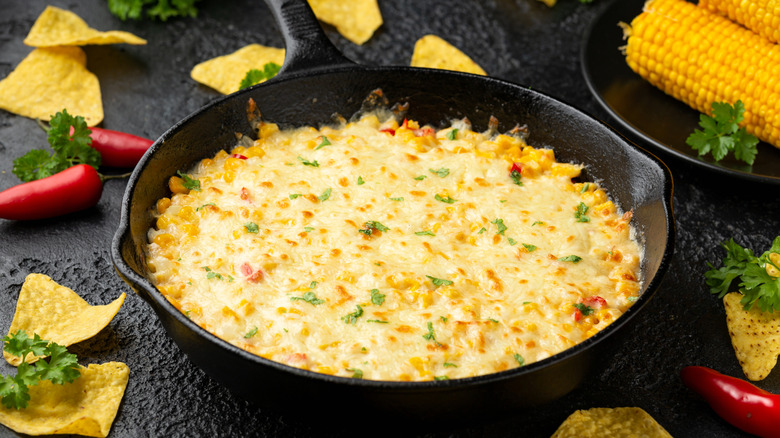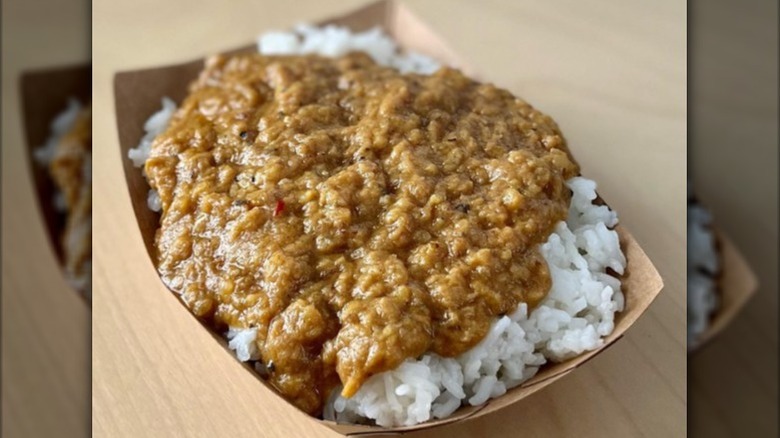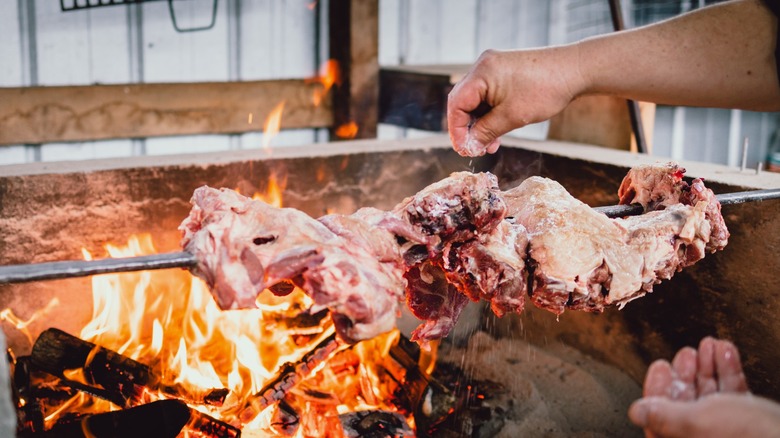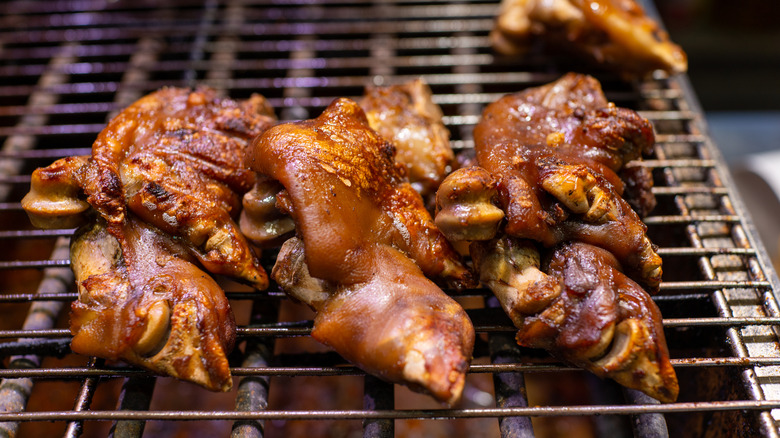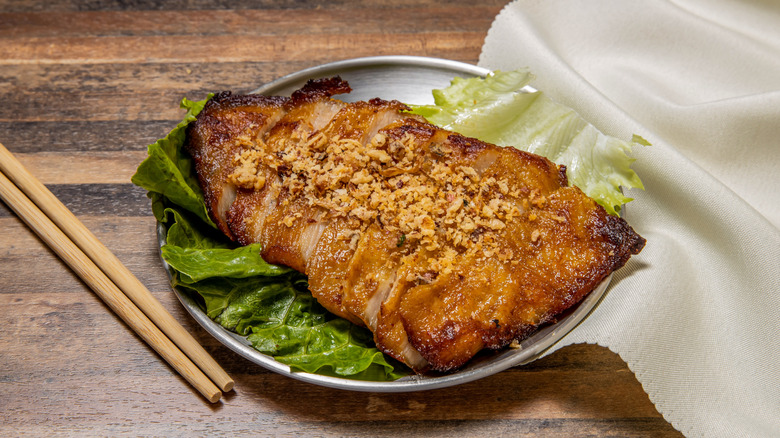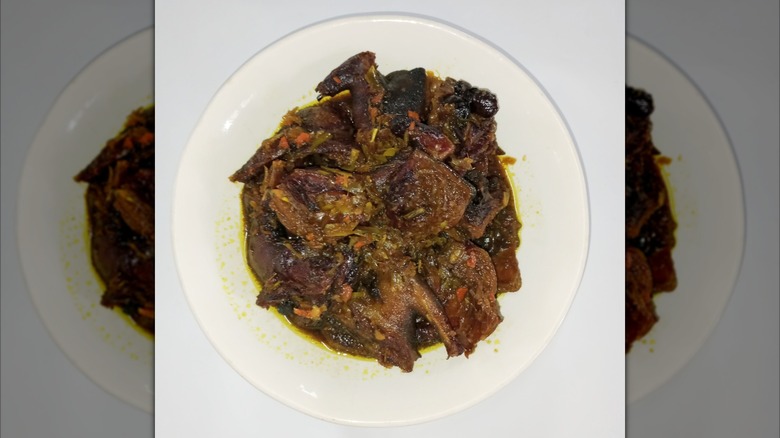Old-Fashioned BBQ Dishes Barely Anyone Eats Anymore
For many of us, barbecues are a long-standing tradition. The process of cooking meat over an indirect flame and adding a few complementary sides has been happening in backyards, fairgrounds, and eateries for decades. Loads of distinct barbecue styles have revealed themselves in America over the years, courtesy of the regions like the barbecue belt. But what were once grill-time essentials have since fallen out of flavor for various reasons, from availability and cultural growth to changing tastes.
We think that Spanish conquistadors brought this Caribbean cooking style to the country centuries ago, and one thing's for sure. Grub cooked slow and low over a bed of hot coals has held a place in our hearts since those European settlers dubbed it "barbacoa." While it's true, you want to think twice before throwing any old foods on your grill, as times change, so does the menu. What those pitmasters of yesteryear served up back then isn't as likely to show up at your local barbecue joint today. Whether you gather the family on a Sunday afternoon for some charred eats or you join the neighborhood for a block party feast, there are many dishes that have stood the test of time, and some that haven't. Let's delve into nine old-fashioned barbecue dishes that barely anyone eats anymore.
Carrot raisin salad
If you've patronized Chick-fil-A anytime over the 40 years it served up carrot raisin salad, you may have been lucky enough to sample this scrumptious southern tradition. While the fast food joint discontinued this menu offering in 2013, we think it's a "gone but not forgotten" kind of dish. While some customers say the reason for its downfall is that pairing carrots and raisins in a salad didn't sound very good, nothing could be farther from the truth. With its sweet and tangy combination of sugar, lemon juice, and creamy mayonnaise, it's quite scrumptious.
Carrot raisin salad was featured in a Good Housekeeping recipe book from 1958, and now it offers barbecue lovers a way to merge deliciously crunchy vegetables with charred meat. One grandma's quick and easy recipe calls for just five ingredients, and once you mix them all together, you'll want to chill the finished product in the refrigerator for at least 30 minutes or better yet overnight. This essential step ensures the flavors meld well before serving the salad with grilled pork or chicken.
Cow's head
Many of us have given up grilling up the occasional cow's head. Afterall, they're not the most popular cut pitmasters are vying for in the 21st century. But once upon a time, this butchering byproduct was consumed all over the world. In fact, braai, or barbecue-style cow head, is considered a Zulu delicacy called Cabeza de Vaca. Despite its rich history, most Americans stopped eating cow's head around 2008 because of an outbreak of mad cow disease. The FDA passed numerous regulations over the years to provide protections against this once "risky meat." However, you can still find it online, if you're so inclined.
Barbacoa is a popular recipe pitmasters use to grill or smoke this unusual cut. One Texan enlisted chef Elizabeth Karmel to help him whip up some authentic cow head tacos. Together, they used a couple cans of beer and a few banana leaves to create the dish, and it's not as unappetizing as its appearance portrays. Topped with bold spices like cayenne, black pepper, and of course, salt, it's a relatively simple process to prep it for the barbecue. If you're wondering how to use this amazingly tender beef, we recommend wrapping the meat in a tortilla and dressing it up just like any homemade taco.
Creamed corn
Canned cream corn is another old-fashioned dish that you may not see around much anymore. Maybe that's because it does seem to have the same texture as throw up, but it can be a terrific barbecue side dish when cooked properly. So, where did this trimming come from anyway? It's believed that creamed corn was an integral part of Native American cuisine, but today it's a classic southern culinary adventure that pairs well with barbecued meat, like steak and pork chops.
Most creamed corn recipes are pretty simple and require just a few ingredients that you may already have on hand. All you need to do to get started is gather your corn, butter, shallots, chives, heavy cream, salt, and pepper. Here's an expert tip: Grill the corn in the husks until charred, right alongside your protein. Then, shuck it, shell it, and add it to your recipe. This extra step only takes 30 minutes or less, and the resulting kernels are oh so yummy with their smoky flavor and tender, juicy texture.
Hash
If you want your cookout's guests salivating over the promise of delicious long forgotten grub, serve some old fashioned hash. This version isn't the potato-based recipe you might whip up for breakfast. It was super popular back in the Roaring Twenties era and unfortunately, it's one of those dishes you probably won't find on many menus now, except maybe in South Carolina. This once iconic southern barbecue side dish is essentially whole hog soup, and not even the organs went to waste here.
Clearly public demand for hash has diminished, but we think it deserves a modern day revival, because it makes a truly tasty barbecue side dish. Making it is a ton of work, and that may be why many chefs have taken it off the menu. While sub-primal pig parts are a common foundational ingredient, what gets tossed in the pot varies wildly depending on who's making it. If you're brave enough to try it, slop it atop a bed of rice and expect a sloppy joe-like texture.
Hoe cakes
Hoe cakes have been around for hundreds of years, but finding them at barbecue gatherings today is like the proverbial needle in a haystack. They're a lot like a cross between a pancake and cornbread, but still very much their own thing. It's believed that they originated with the Algonquian culture who then shared the recipe with colonists. These indigenous people made their version with just cornmeal and hot water, and it worked. Even George Washington wasn't immune to its charms, as hoe cakes and honey were one of the first president's favorite foods.
Impress your guests with something different and dish up a few hoe cakes at your next barbecue. They fit nicely on a plate next to savory staples, like honey-infused pulled pork. Just toss some shredded pig on a warm cornmeal slab, drizzle it with your favorite sauce, and dig in. Hoe cakes don't take a ton of time to whip up, and you only need a few ingredients to recreate this quintessential recipe, like cornmeal, salt, pepper, egg, buttermilk, and bacon grease. Heat your cast-iron skillet on the grill and pan fry each cake until it develops a golden brown crust on both sides.
Mutton
You may have heard of mutton, and if you're like most of us, you probably thought it was lamb. Well, it is. Sort of. Mutton comes from adult sheep, whereas lamb comes from younger animals. This cut isn't usually as tender as lamb, but it typically contains more fat, which means juicier flavor off the grill. We think barbecued mutton calls for a comeback, so consider bonding with loved ones over a plate of this smoky masterpiece, which is a Kentucky tradition.
Some of the tastiest melt-on-your tongue barbecued mutton recipes call for aromatic herbs like rosemary, thyme, garlic and pepper. Some home chefs like to slow-smoke the meat over hickory coals first and then give it a good sear on the hot side of the grill. What you're left with is a cut that's so tender, it falls off the bone. Remember to baste it well, then pull or chop it, depending on your preference. Try serving it between a couple slices of bread with a Worcestershire-heavy dipping sauce. Or, if the occasion calls for something a bit more cosmopolitan, plate it with a side of roasted potatoes and your veggie of choice.
Pig's feet
While you can probably find a gallon jar of pickled pig's feet at a smattering of grocery stores south of the Mason-Dixon Line, the raw variety used for grilling is seemingly absent from most grocery lists today. Whether it's their unappetizing appearance or the wide availability of other cuts of pork, you don't see a lot of trotters on the barbie anymore. Historically, many poor southerners could only get their hands on "undesirable" cuts of meat, like pig's feet. So, in order to make them more palatable, grillers tossed them on the fire for a bit of slow and low roasting. This soul food culinary tradition was typically smothered in barbecue sauce to enhance the flavor.
If you're up for recreating this culinary tradition, you can find a recipe or two online. One YouTuber simmers his pig's feet in water until tender, then he lets the seasoned trotters sit in a smoker for about an hour. We recommend serving them up with southern classics like collard greens and a heaping helping of mac n' cheese.
Pork jowl
Yes, we know what you're thinking. Doesn't pork jowl come from a hog's cheek? Indeed it does, and with its rich marbling and tender texture, it's a wonder that it's such an underutilized cut in 2025. That wasn't always the case, though. Once, pork jowl was a favorite among pitmasters, and its culinary history spans years and continents. In fact, Italians were some of the earliest people to cure pork jowl like bacon. Macellaios produced a product called guanciale with this unique cut, and that's not all. It was an essential ingredient in other cultural dishes, as well.
This thin, flat, and grill-friendly meat stars in a classic Thai barbecue pork dish called kaw moo yang. While it may be hard to find pork jowl for this recipe now-a-days, you can look for it at your local Asian supermarket or a specialty butcher. Season the cut with a tasty marinade made from traditional herbs and spices like garlic, white peppercorns, lemongrass, palm sugar, coconut milk, and soy sauce. You'll want to pre-heat and oil your grill and keep the lid open to prevent overcooking. It doesn't take more than a few minutes to barbecue pork jowl. Rest the grilled meat atop a bed of rice and enjoy.
Squirrel
Squirrels are pretty adorable, except perhaps when they empty your bird feeders. But not many of us look at this fluffy-tailed varmint and declare, "That's what's for dinner." While that's a sure sign of the times, once in American history, barbecue squirrels were a big part of our menu. It earned its rightful place in barbecue history, as it was definitely a favorite among pioneers. After all, there weren't a lot of grocery stores back then, and most families put whatever was available on the table.
Squirrel has a finer texture than rabbit, but it's perfectly permissible to serve it with the same types of side dishes, like pasta and rice. It's usually a good choice to opt for the haunches when barbecuing, as that's the meatiest part of the squirrel. You can soak it in a brine to remove some of its gamey flavor, then slow roast it on the grill. So, what does squirrel taste like and is it safe to eat them considering today's rodent-adverse culture? Yes, it is safe to eat squirrels and some say they have a sweet and wait for it: Nutty flavor.



